Need ideas for Portable Gas Grills? If you’re short on time and just want the verdict – the Weber Q1200 is hands-down the best portable gas grill overall. It nails the sweet spot between performance, portability, and build quality. (Do you need marine grade, portable gas grills for your boat? Read this incredible gas grill roundup for your offshore cooking HERE.)
But if you’re like me and enjoy a little grill talk before lighting up the burners, stick around. Portable gas grills have become the go-to gear for campers, tailgaters, beach lovers, and anyone who refuses to eat bland food outdoors.
Finding the right one, though? That’s where people usually burn their fingers – sometimes literally. So let’s break down what really matters before you spend your money (or ruin another rack of ribs in the woods).
We’ll also review the top contenders in the portable gas grill game, including:
- Weber Q1000
- Weber Q1200
- Coleman RoadTrip LXE
- Weber Portable Gas Grill
- Cuisinart CGG-180T Petit Gourmet
- Pit Boss Grills 75275
- Coleman RoadTrip 285
- Cuisinart Petite Gourmet Grill
What to Look for When Buying a Portable Gas Grill
BTUs – Don’t Fall for Big Numbers
You’ll see BTUs (British Thermal Units) plastered all over grill boxes like they’re horsepower stats. In short, BTUs measure heat output. The higher the BTUs, the hotter your grill can get – but here’s the kicker: BTUs mean nothing without good heat retention.
I’ve cooked on thin, cheap grills that looked great on paper with “20,000 BTUs!!!” but barely seared a burger. Why? Because all that heat escaped faster than a politician’s promise.
Key takeaway: Look for efficient construction, not just inflated BTU numbers. Heavy-duty lids, cast aluminum bodies, or enameled steel chambers trap and reflect heat better.
And yes, more BTUs = faster propane burn. So if you’re trying to stretch a tank over a long weekend, moderation wins.
Temperature Control – Precision Over Power
Most tabletop gas grills come with a single control knob. That’s fine for simplicity, but if your grill has two burners, make sure it has dual temperature zones.
That’s a game-changer for multitasking – sear your steak on one side, warm your veggies on the other.
A pro tip from experience: if you can find a model with a fine-tuned adjustment knob, you’ll have far better control over low-and-slow cooks. Cheap knobs tend to swing wildly from “barely on” to “blast furnace.”
Precision is everything when you’re chasing that perfect crust without cremating dinner.
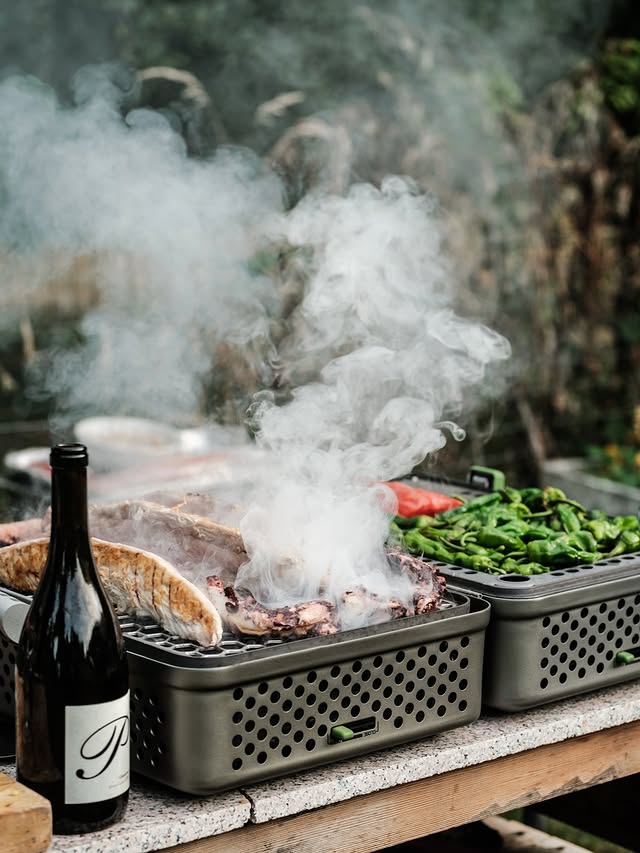
Cooking Surface Area – Size Actually Matters
Let’s talk real estate. Most portable gas grills hover between 150–300 square inches of cooking area.
To give you perspective:
- 200 sq. in. = roughly 12 burgers or two steaks, two potatoes, and corn on the cob.
- A general rule: 100 sq. in. per person if you’re feeding a crowd.
If you’re a solo camper or tailgating duo, smaller is better – less fuel, less cleanup. But if you’re grilling for the squad at the game, get something with a fold-out or expandable grate system.
Burners – Go Stainless or Go Home
The burner is your grill’s engine, and not all are created equal.
Here’s what lasts:
- Stainless steel burners – Best balance of heat consistency and corrosion resistance.
- Brass burners – Great heat, but rare and pricey.
- Cast-iron burners – Heat well but rust easily.
- Aluminum burners – Cheap and short-lived.
Also, look for a metal heat deflector or “flavorizer bar” between the burner and the grate. It evens out heat and protects against grease drips that can flare up like fireworks.
Grill Grates – Where the Magic Happens
The grate makes or breaks your sear. Here’s the quick rundown:
- Nickel/Chrome-Plated Wire: Light, cheap, rusts easily. Fine for occasional trips.
- Stainless Steel: Easy to clean, decent heat retention, and weather-friendly.
- Cast Iron: The king of searing. Holds heat like a champ but needs oiling to prevent rust.
If you’re serious about grilling, cast-iron grates are worth the maintenance. Nothing gives you that photo-worthy sear pattern like it.
Ignition System – Click and Cook
Almost every modern portable gas grill uses a spark ignition system – either push-button, rotary dial, or battery-powered. They’re convenient until they fail (and they will, eventually). That’s why a manual ignition hole is a must-have.
Keep a long match or lighter handy, and you’ll never be stuck with raw food and false promises.
Build Quality – Feel the Weight
A rule I’ve lived by: if a grill feels flimsy in your hands, it is.
Top materials to look for:
- Stainless Steel: Resists corrosion and holds heat well.
- Cast Aluminum: Lightweight but sturdy. Ideal for travel.
- Cast Iron: Built like a tank, but it’s heavy. Great if you’re not hiking miles with it.
- Enameled Steel: Won’t rust but chips if handled roughly.
Personal note: I once lugged a full cast-iron grill up a hill to a lakeside camp. Amazing food, yes. But the next morning, I bought a portable gas grill instead – one with a handle, wheels, and collapsible legs. Lesson learned.
Portability – The Whole Point
If it’s not easy to carry, it’s not truly portable.
Look for:
- Lid latches to secure everything during transport.
- Foldable legs or collapsible frames.
- Carrying handles or wheels for long hauls.
I’ve cursed enough heavy grills in the woods to tell you: go light or go home. The best models fold into compact forms and fit right in your trunk.
Bonus: some even come with custom travel bags – perfect for keeping things clean and contained between trips.
Fuel Options – The Tank Situation
Most portable gas grills run on 1-pound propane canisters, the kind you can pick up at any camping store. They’re easy, cheap, and good for a couple of meals.
However, if you grill often, a 20-pound propane tank is more economical. You’ll need a conversion kit (around $100), which lets you hook your portable grill to a standard backyard tank.
Just know this: conversion kits make sense for stationary setups (like tailgates or patios). If you’re constantly moving, stick to the small canisters. Swapping those out is way less hassle than dragging a 20-pounder across a beach.
Heat Distribution – The Secret Sauce of Even Cooking
You can have the most powerful burners on the planet, but if your grill doesn’t spread heat evenly, you’ll end up with half-burnt burgers and half-raw sausages. Even heat distribution separates the great portable gas grills from the rest.
Look for heat diffusers or flame tamers – metal plates or bars that sit between the burners and the grates. These spread heat across the cooking surface and prevent flare-ups by catching dripping grease.
Grills with solid lids and heavier bodies (like cast aluminum or thick steel) also trap and circulate heat more efficiently.
Cheap, lightweight lids? They leak warmth like a sieve. In short: if your grill can keep the heat consistent from corner to corner, you’re guaranteed juicier meat, better sears, and fewer “well-done on one side” disasters.
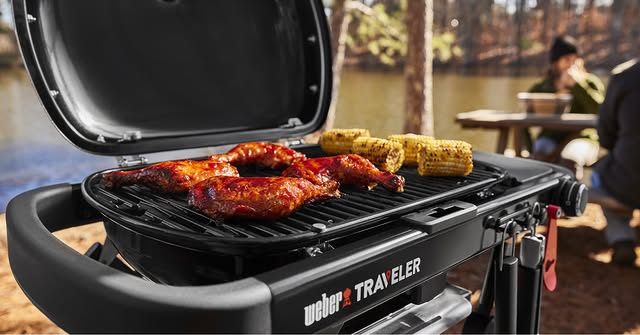
Maintenance and Durability – Built to Survive the Road
Portable doesn’t mean disposable. The best portable gas grills are built to take a beating – road trips, tailgates, salt air, and the occasional clumsy drop. Look for stainless steel hinges, rugged handles, and sturdy latches that won’t wobble after one summer.
Easy maintenance is just as crucial. Removable grease trays, wipeable surfaces, and rust-resistant finishes will keep your grill in rotation for years instead of one season. Avoid models that rely heavily on painted steel – that paint will blister and peel after a few heat cycles.
Personally, I always look for tool-free disassembly so I can deep-clean it after a camping weekend. A clean grill is a happy grill – and a happy grill master means fewer headaches and better-tasting food.
Versatility and Add-Ons – More Than Just a Grill
Today’s portable gas grills aren’t just one-trick ponies. Some come with interchangeable cooktops – swap your grate for a griddle, wok, or stove attachment to cook pancakes, bacon, or stir-fry in the wild.
Others offer side tables, built-in thermometers, or warming racks that turn your tailgate setup into a mini outdoor kitchen. It’s worth checking which accessories are compatible with your grill – sometimes a small upgrade turns an average grill into your new favorite toy.
If you like experimenting, pick a model that supports modular cooking so you can mix it up depending on the trip. Remember, versatility isn’t about gimmicks – it’s about getting the most out of your heat source without lugging your entire backyard setup around.
Real-World Use – How Portable Is “Portable”?
Manufacturers love to call everything “portable,” but let’s be real – not all grills deserve that title. A true portable gas grill should be light enough to carry solo, compact enough to fit in your trunk, and tough enough to survive rough terrain.
Weight, handle design, and setup time matter just as much as cooking performance. Some models fold up neatly with rolling carts, while others are meant to sit on tabletops or tailgate ledges. Think about where you’ll actually use it – beach, campsite, parking lot – and match the design to your lifestyle.
I’ve tested plenty that looked great online but felt like hauling a car battery once packed. If portability isn’t effortless, it defeats the whole purpose of going mobile with your grill.
Best Portable Gas Grills in 2025 – Hands-On Reviews from a Pitmaster
If you’re just here for the winner – the Weber Q1200 takes the crown. It’s the best portable gas grill for 2025, blending power, precision, and portability in a way that makes every campsite or tailgate feel like your backyard kitchen.
But if you’re like me – someone who enjoys the sound of sizzling meat and the faint smell of propane in the morning – stick around. We’ll break down the best of the best in portable gas grills that make outdoor cooking fast, flavorful, and fun.
I’ve grilled on parking lots, riverbanks, and forest clearings, and trust me – the right gear makes all the difference.
Below are my hands-on reviews of the top 5 portable gas grills that deliver big performance in small packages.
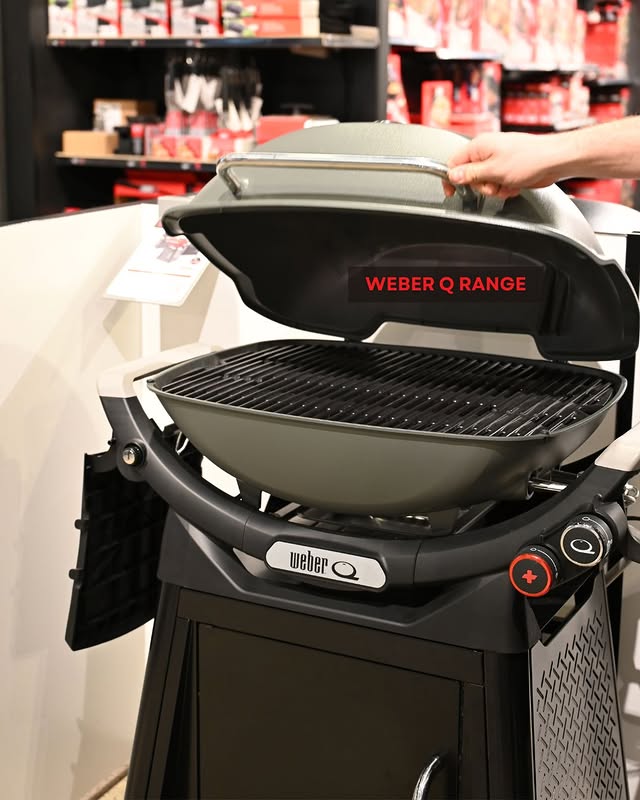
1. Weber Q1000 – Compact Powerhouse for Everyday Adventures
The Weber Q1000 is what I call a “grab-and-grill” champion. It’s compact, tough, and ridiculously easy to use – perfect for road trips, picnics, or spontaneous cookouts by the lake.
Built with a cast-aluminum body and lid, the Q1000 is both lightweight and durable, making it ideal for constant travel. It runs on disposable LP cylinders, so you can fire it up anywhere.
If you’d rather keep it stationary at home, you can hook it up to a 20-pound propane tank with an optional adapter hose.
Under the hood, you get 8,500 BTUs of heat from a single stainless-steel burner across a 189 sq. inch cooking area – just enough for burgers, brats, or a quick steak dinner for two.
The porcelain-enameled cast-iron grates hold heat beautifully and clean up easily, even after a messy marinade session.
Ignition is handled by a push-button system, and while simple, it’s reliable enough that you won’t be stuck clicking it ten times in front of hungry guests.
This is the kind of grill you take on a weekend getaway and end up using all year long – even on your balcony.
Pros:
- Excellent heat control for a single-burner grill
- Porcelain-enameled grates are durable and easy to clean
- Compact design fits perfectly into tight storage spaces
- Simple push-button ignition
Cons:
- The split grate design isn’t everyone’s favorite
- Runs hot even on low – not ideal for delicate cooking
Verdict:
The Weber Q1000 proves that great things come in small packages. It’s portable, efficient, and cooks evenly – everything a traveler or casual griller could ask for.
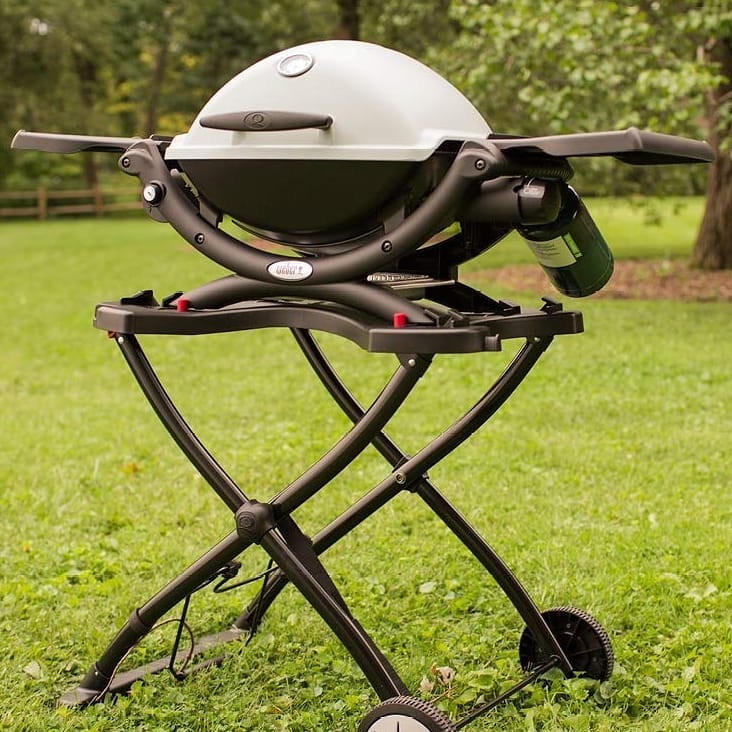
2. Weber Q1200 – The Portable Grill That Acts Like a Full-Size Beast
If the Q1000 is the apprentice, the Weber Q1200 is the master. It’s easily one of the best portable gas grills you can buy in 2025 – refined, powerful, and built to outlast most tailgates.
Like its smaller sibling, the Q1200 features a cast-aluminum body and porcelain-enameled cast-iron grates. But it steps up the design game with larger grip handles, fold-out side tables, and an integrated thermometer built right into the lid.
The taller lid also means you can roast small chickens or roasts – not something most tabletop grills can brag about.
It packs the same 8,500 BTUs of power over 189 sq. inches of cooking space, but what sets it apart is temperature precision. The burner control knob allows fine-tuned adjustments, so you can move from low-and-slow to searing-hot without guesswork.
Ignition is now electronic, giving you consistent starts every time. And when you’re on the road, it runs on disposable 1-pound propane cylinders, or you can attach a 20-pound tank at home using an adapter.
This grill doesn’t just look good – it cooks like a champ. From bacon and eggs in the morning to steaks at sunset, the Q1200 handles it all without breaking a sweat.
Pros:
- Performs like a full-size gas grill in a compact form
- Built-in thermometer for easy temperature monitoring
- Fold-out tables add valuable prep space
- Nonstick grates clean up effortlessly
Cons:
- Slightly expensive for a tabletop model
- Propane canister connection can be tricky at first
Verdict:
The Weber Q1200 earns the top spot because it’s portable perfection. Smart design, serious heat control, and quality materials make it the ultimate road-trip or balcony grill. It’s worth every penny.
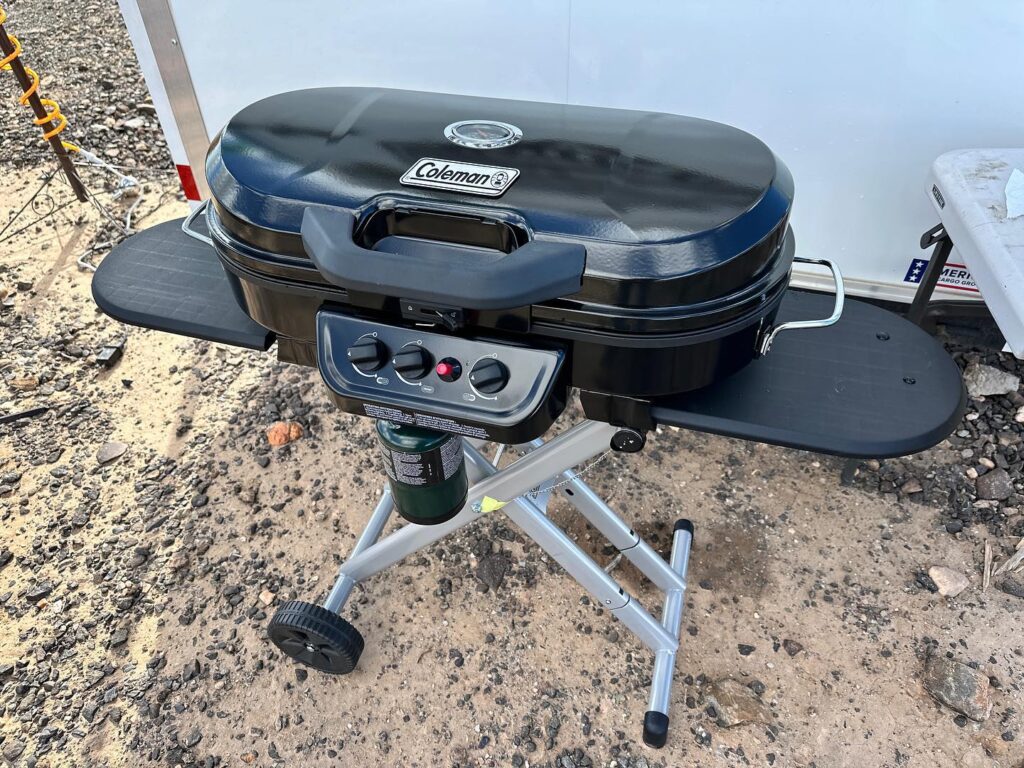
3. Coleman RoadTrip LXE – The Tailgater’s Workhorse
If you’re a tailgater, camper, or anyone who cooks outdoors regularly, the Coleman RoadTrip LXE might just be your new best friend. This thing is made to move – it folds, rolls, and sets up faster than most people can find their tongs.
The collapsible design is one of its best tricks. With a lift-and-lock system, setup takes just seconds, and the integrated wheels and handle make it easy to roll to your spot.
Once it’s in place, you get a full 285 sq. inch cooking surface and 20,000 BTUs of power split between two adjustable burners.
The cast-iron grates are porcelain-coated for easy cleanup, and with the Swaptop cooktop system, you can switch to a griddle or stove grate depending on what’s on the menu. I’ve done everything from pancakes to pork chops on this thing – it handles it all.
Lighting is a breeze thanks to the InstaStart ignition, which eliminates the need for matches. Plus, the PerfectFlow Pressure Control System keeps the heat steady, even on cold or windy days — a big deal for outdoor cooks.
Pros:
- 285 sq. inches of cooking space – plenty for a small crowd
- Folds and rolls like luggage for true portability
- Consistent heat output thanks to pressure control
- Swaptop system adds versatility
Cons:
- Cleaning requires partial disassembly
- Can be awkward to hook up to RV or trailer propane systems
Verdict:
The Coleman RoadTrip LXE is built for movement and muscle. It’s perfect for tailgaters and campers who want real cooking power on the go. Just be ready to give it a quick scrub-down after the feast.
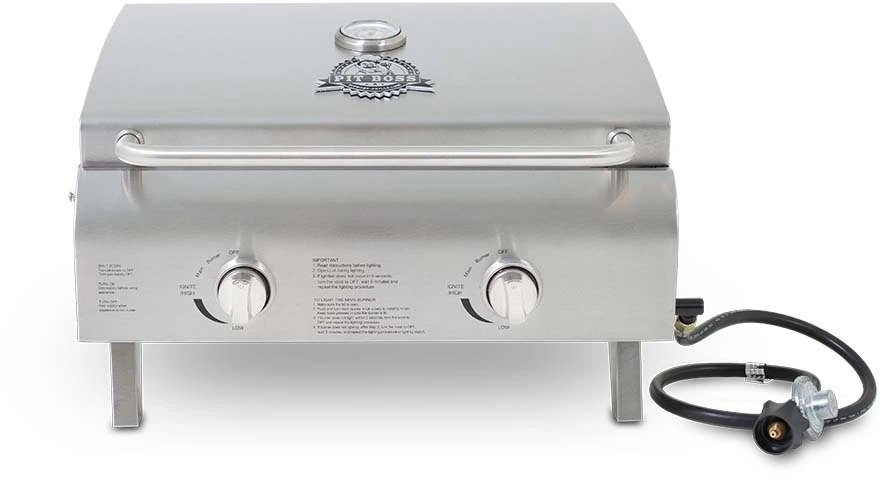
4. Pit Boss 200P – Small Grill, Big Attitude
Don’t let the compact design fool you – the Pit Boss 200P has the kind of power that surprises even seasoned grillers. This thing was clearly made for those who want serious heat and control in a small form factor.
The 200P puts out 20,000 BTUs across 275 sq. inches of cooking area, powered by two stainless-steel burners with independent controls.
That dual-zone setup gives you the ability to sear on one side while keeping food warm on the other – a rare luxury for portable gas grills.
Its stainless-steel body looks sharp, resists corrosion, and gives it a premium feel. Inside, the stainless cooking grates are solid, and there’s a built-in thermometer on the lid for easy monitoring. A push-and-turn ignition system keeps startup quick and reliable.
At just over 20 pounds, it’s compact enough to stash in your trunk and take to the beach, tailgate, or fishing trip. The folding legs and locking lid make transport a breeze.
Pros:
- Two independently controlled burners for dual-zone cooking
- 20,000 BTUs of serious grilling power
- Sleek stainless-steel construction
- Even heat distribution – no hotspots
Cons:
- Sharp-edged legs – handle with care
- The metal could be thicker for better durability
Verdict:
The Pit Boss 200P is compact, powerful, and precise – a perfect grill for those who take their food (and their flame) seriously. It’s proof that small doesn’t mean weak.
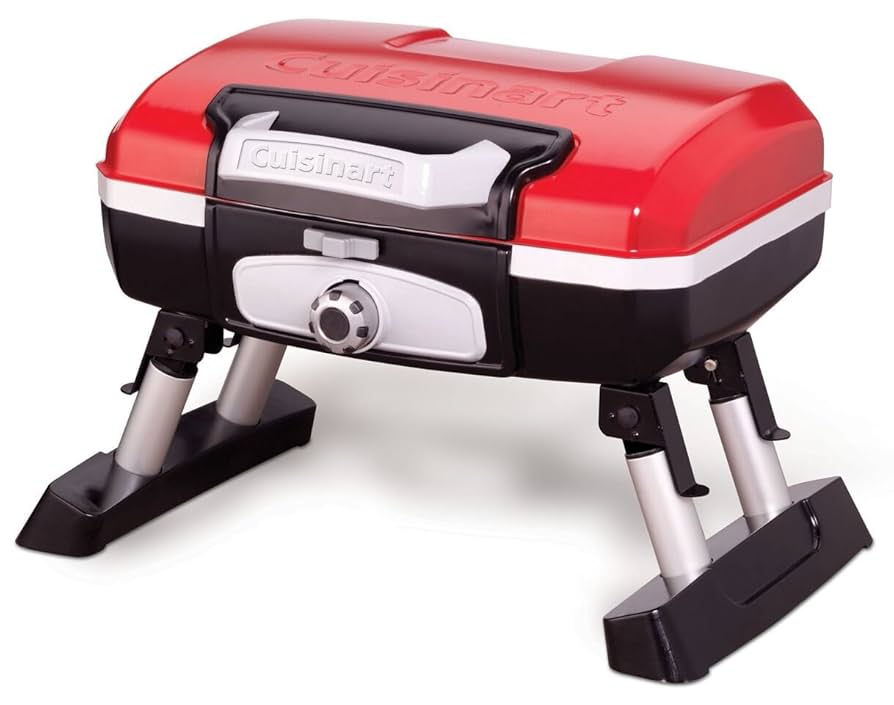
5. Cuisinart CGG-180T Petit Gourmet – Mighty Mini for Solo Grillers
When space is tight but taste still matters, the Cuisinart CGG-180T Petit Gourmet is a clever little grill that delivers big flavor in a pint-sized frame.
At just 13.5 pounds, it’s the most portable model on this list – and ideal for solo adventurers or couples on the move.
It’s powered by a 5,500 BTU stainless-steel burner, which might sound modest, but paired with a porcelain-enameled grate and compact 145 sq. inches of cooking space, it heats evenly and efficiently.
You can grill four burgers, a few kebabs, or even a pair of steaks without crowding the surface.
The folding aluminum legs, stabilizing feet, and locking lid make setup and transport quick and secure. It even comes with a briefcase-style handle – a nice touch for anyone who hikes or picnics regularly.
It’s not made for large cookouts, but as a personal portable gas grill, it’s one of the easiest to handle and clean.
Pros:
- Extremely lightweight and compact (13.5 lbs)
- Quick setup with folding legs and locking lid
- Efficient fuel usage – perfect for weekend trips
- Heats up fast and cools down quickly
Cons:
- Short hose limits placement flexibility
- Low setting still runs hot for delicate items
Verdict:
The Cuisinart Petit Gourmet is your no-fuss, no-mess travel buddy. It’s not the most powerful, but it’s so easy to carry and clean that you’ll find yourself taking it everywhere. Perfect for solo campers and quick picnics.
Best Portable Gas Grill – Final Verdict
After countless burgers, wings, and early-morning breakfasts cooked in the great outdoors, one grill stands out from the pack: the Weber Q1200.
Why? Because it combines everything that matters in a portable gas grill – build quality, heat control, design, and ease of use. It’s compact enough to take anywhere, but powerful enough to cook anything.
The cast-aluminum body resists rust, the cast-iron grates deliver perfect sear marks, and the built-in thermometer makes temperature management effortless.
You can run it on small propane canisters for travel or connect it to a 20-pound tank for backyard use. It’s the only grill I’ve used that truly feels like a full-size model shrunk down for adventure.
Bottom line:
If you want a grill that performs flawlessly whether you’re tailgating, camping, or just cooking on your patio, the Weber Q1200 is the clear winner. It’s not just the best portable gas grill in 2025 – it’s the one you’ll still be using five years from now.
Buying Guide: What to Look for in a Portable Gas Grill (2025 Edition)
Choosing the best portable gas grill isn’t just about size or brand – it’s about how well it fits your cooking lifestyle. Before you hit the road or set up camp, consider a few key factors that can make or break your grilling experience.
Portability is the first thing to look at. If you’re a frequent camper or tailgater, go for models with folding legs, handles, or wheels like the Coleman RoadTrip LXE. For backpackers or solo travelers, a compact tabletop option such as the Cuisinart Petit Gourmet is ideal.
Next comes power and heat control. Look for a grill with at least 8,000–10,000 BTUs per burner to ensure even heat distribution and quick searing. Dual-burner setups like the Pit Boss 200P give you more versatility for cooking multiple foods at different temperatures.
Material quality matters too. Grills built with cast aluminum or stainless steel resist rust and wear from outdoor use. Meanwhile, porcelain-enameled cast-iron grates retain heat and leave those perfect sear marks you want on steaks and burgers.
Don’t overlook ignition systems – push-button or electronic igniters make startup fast and reliable. If you plan to cook larger meals, check the cooking area (anything around 180–285 sq. inches is plenty for small gatherings).
Finally, consider fuel compatibility. Some models run on 1-pound propane cylinders, while others can connect to 20-pound tanks with an adapter – ideal if you switch between travel and home grilling.
Pitmaster’s tip: A great portable gas grill should balance size, power, build quality, and convenience. Whether you’re chasing sunsets or hosting tailgates, the right grill makes every meal outdoors taste like home.
Read our review of the best small gas grills here.

